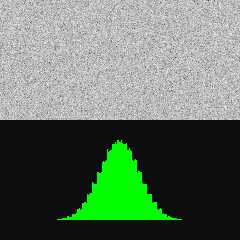|
 |
About a year ago I was playing some with an idea for a facets normal
perturbation.
Ref:
https://news.povray.org/povray.pov4.discussion.general/thread/%3C652b157c%40news.povray.org%3E/
As part of that work I mentioned using the population count opcode in
most modern processors as part of a creating a normal-ish /
sloppy-Gaussian distribution of not more than 64 values.
I had the thought at the time, we could probably extend the technique to
random noise generation too.
Release (R16) of yuqk is adding a new inbuilt function called
f_popnrm_rnoise(). Attached is an image of the +-1 noise created (no AA)
and a histogram of the value distribution.
pigment {
function { f_popnrm_rnoise(x,y,z,now,1) }
function_interval
color_map {
[-1.0 rgb 0]
[+1.0 rgb 1]
}
}
The steps of the technique are certainly visible, but for a really fast,
normal-ish, random, noise distribution - I think it will often be useful.
Bill P.
Hmmm, I wonder what happens if I use this directly as an isosurface
function... To a first order, renders a noisy shape constrained by the
container. Relatively quick, but HUGE max gradients need be ignored. :-)
Mind running - what if we stick this noise only inside more usual shape
functions or inbuilt shapes as part of a function. I bet they'd all show
up... Anyhow. More play to be had I guess.
Post a reply to this message
Attachments:
Download 'f_popnrm_rnoise_story.png' (149 KB)
Preview of image 'f_popnrm_rnoise_story.png'

|
 |




![]()